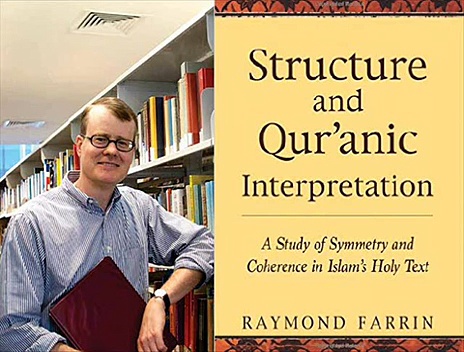One other miraculous aspect of the Qur’an which I personally interested in is its astonishingly coherence and unity in its structure and contents.
Interest in the structure of the Qur’an has its beginnings in the ninth century CE with Muslim scholars. Since that time, Muslim and Western scholars have debated the coherence of the Qur’an’s structure.
I have just bought a scholarly yet easy to read introductory book for this particular aspect of the Qur’anic study which I recommend anyone to read for those interested in the structure of the Qur’an :
Raymond Farrin is professor of Arabic at the American University of Kuwait. He studied Arabic in Cairo and received a Ph.D. in Near Eastern Studies from the University of California, Berkeley. He is author of Abundance from the Desert: Classical Arabic Poetry (Syracuse UP, 2011).
This is Prof. Farrin newest book in which he studied patterns of connectivity between verses and chapters. Farrin argues that the entirety of Qur’an is organized according to three common patterns of symmetry: parallelism, chiasm, and, the most ubiquitous of three, concentrism.
Professor Farrin explores patterns of symmetry which are found in the individual chapters, chapter pairs, groupings of chapters, systems of chapters, and then the entire corpus. This structural analysis provides him the opportunity to explore the overall connectivity of messages throughout the Qur’an.
He wrote in the conclusion chapter:
The Qur’an is a text whose form perfectly supports its meaning. The five main points, as we have noticed, all point to God: The beginning calls on Him, the ending seeks refuge in Him, the middles of the two systems are oriented to the place of His manifestation on earth, and the center is oriented to Him above. Correspondences are numerous and dense, to be sure, but overall they follow a single concentric plan. Parallels and symmetries throughout underscore a greater unity. Every formal element refers to the One God.
This book also accompanied by multiple appendixes providing structural analysis of selected chapters, a complete listing of chapter pairs and groups, a “Reading Group Guide” of revelations mentioning prophets, and a chronological listing of chapters based on the work of Nöldeke.
Prof. Raymond Farrin is one of the most recent of Qur’an scholar following the works of numerous other western scholars in the field who have followed their lead and have begun to show clearly that individual chapters in the Qur’an, both short and long, are indeed characterized by a high degree of unity. Of these, one may single out for mention Angelika Neuwirth, Pierre Crapon de Caprona, Mustansir Mir, Muhammad Abdel Haleem, Matthias Zahniser, Neal Robinson, Carl Ernst, and, especially, Michel Cuypers. This book develops out of the work of these various predecessors in the area of modern textual criticism. It affirms that the whole Qur’an, including all its arranged parts, possesses a magnificent design.
Professor Farrin’s work is a significant contribution to the field. It is of great value to scholars of Islam however written in terms accessible to all interested in exploring the Qur’an.
Categories: Quran, Recommended Reading

This is a great book. I read it and loved it…written so clearly…and the intricacy, depth, and breadth of the ring structures throughout the Qur’an so amazing.
Paul, I hope you add it to your wonderful book collection.
LikeLiked by 2 people
I really want to read this book. I listened to Farrin’s interview on this very book
LikeLiked by 1 person